#district de fatih
Explore tagged Tumblr posts
Text
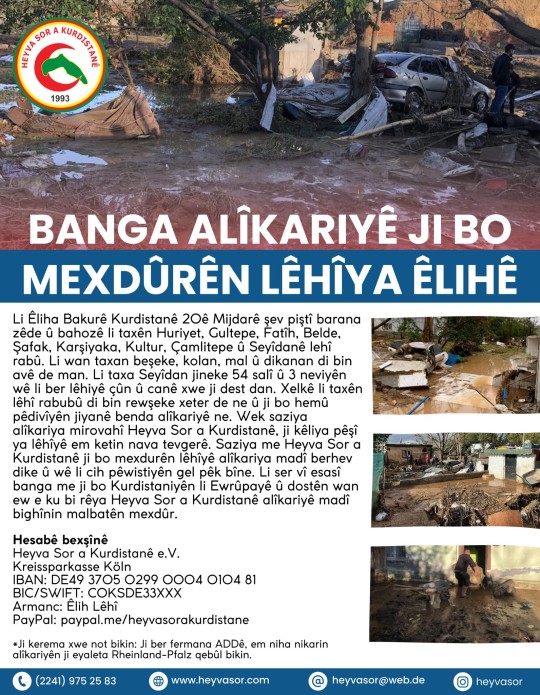


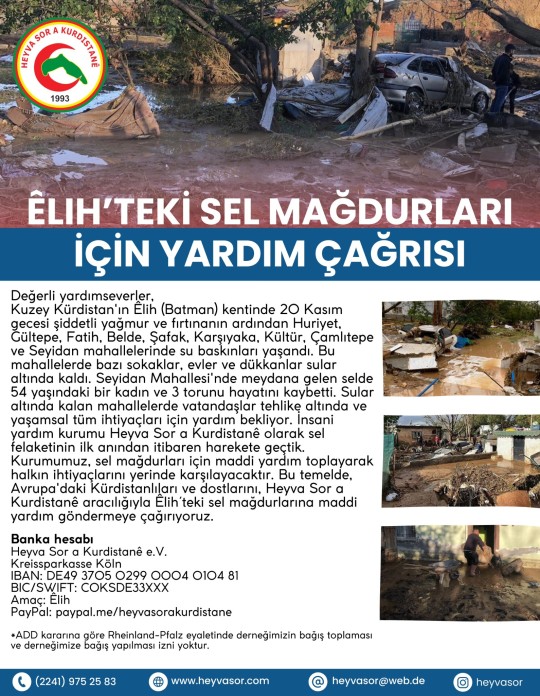
BANGA ALÎKARIYÊ JI BO MEXDÛRÊN LEHÎYA ÊLIHÊ
Li Êliha Bakurê Kurdistanê 20ê Mijdarê şev piştî barana zêde û bahozê li taxên Huriyet, Gultepe, Fatîh, Belde, Şafak, Karşiyaka, Kultur, Çamlitepe û Seyîdanê lehî rabû. Li wan taxan beşeke, kolan, mal û dikanan di bin avê de man. Li taxa Seyîdan jineke 54 salî û 3 neviyên wê li ber lehiyê çûn û canê xwe ji dest dan. Xelkê li taxên lehî rabubû di bin rewşeke xeter de ne û ji bo hemû pêdivîyên jiyanê benda alîkariyê ne.
Wek saziya alîkariya mirovahî Heyva Sor a Kurdistanê, ji kêliya pêşî ya lehîyê em ketin nava tevgerê. Saziya me Heyva Sor a Kurdistanê ji bo mexdurên lehîyê alîkariya madî berhev dike û wê li cih pêwistiyên gel pêk bîne.
Li ser vî esasî banga me ji bo Kurdistaniyên li Ewrûpayê û dostên wan ew e ku bi rêya Heyva Sor a Kurdistanê alîkariyê madî bighînin malbatên mexdûr.
Hesabê bexşînê:
Heyva Sor a Kurdistanê e.V.
Kreissparkasse Köln
IBAN: DE49 3705 0299 0004 0104 81
BIC/SWIFT: COKSDE33XXX
Armanc: Êlih Lehî
PayPal: paypal.me/heyvasorakurdistane
*Ji kerema xwe not bikin:
Ji ber fermana ADDê, em niha nikarin alîkariyên ji eyaleta Rheinland-Pfalz qebûl bikin.
--------------------------------------
Spendenaufruf für die Flutopfer in Êlih
Nach heftigen Regenfällen und Stürmen in der Nacht zum 20. November in der nordkurdischen Stadt Êlih (Batman) kam es in den Stadtteilen Huriyet, Gültepe, Fatih, Belde, Şafak, Karşıyaka, Kültür, Çamlıtepe und Seyidan zu Überschwemmungen.
Einige Straßen, Häuser und Geschäfte in diesen Stadtteilen wurden überflutet. Eine 54-jährige Frau und ihre drei Enkelkinder kamen bei den Überschwemmungen im Stadtteil Seyidan ums Leben. Die Bürger*innen in den überschwemmten Vierteln sind in Gefahr und warten auf Hilfe für alle ihre lebenswichtigen Bedürfnisse.
Als humanitäre Hilfsorganisation Heyva Sor a Kurdistanê haben wir vom ersten Moment der Überschwemmung an gehandelt. Unsere Organisation wird die Bedürfnisse der Menschen vor Ort erfüllen, indem sie finanzielle Hilfe für die Flutopfer sammelt.
Auf dieser Grundlage rufen wir dazu auf, den Flutopfern in Êlih über Heyva Sor a Kurdistanê finanzielle Hilfe zukommen zu lassen.
Spendenkonto:
Heyva Sor a Kurdistanê e.V.
Kreissparkasse Köln
IBAN: DE49 3705 0299 0004 0104 81
BIC/SWIFT: COKSDE33XXX
Verwendungszweck: Flutkatastrophe Êlih
PayPal: paypal.me/heyvasorakurdistane
*bitte beachten:
Durch eine Verfügung seitens der ADD Rheinland-Pfalz können wir aktuell keine Spenden aus dem Bundesland Rheinland-Pfalz annehmen.
----------------------------
Call for donations for Flood Victims in Êlih
Following heavy rains and storms on the night of November 20 in the northern Kurdish city of Êlih (Batman), flooding occurred in the districts of Huriyet, Gültepe, Fatih, Belde, Şafak, Karşıyaka, Kültür, Çamlıtepe, and Seyidan. Some streets, houses, and shops in these neighborhoods were flooded. Unfortunately, a 54-year-old woman and her three grandchildren lost their lives in the floods in the Seyidan neighborhood. Citizens in the affected areas are in danger and urgently await assistance for their essential needs.
As the humanitarian aid organization Heyva Sor a Kurdistanê, we have been actively responding since the initial moments of the flooding. Our organization aims to address the immediate needs of the affected people on the ground by collecting financial aid for the flood victims.
On this basis, we appeal for financial contributions to be sent to the flood victims in Êlih through Heyva Sor a Kurdistanê.
Bank account:
Heyva Sor a Kurdistanê e.V.
Kreissparkasse Köln
IBAN: DE49 3705 0299 0004 0104 81
BIC/SWIFT: COKSDE33XXX
Reference: Flood Êlih
PayPal: paypal.me/heyvasorakurdistane
*Please note:
Due to an order from the ADD Rheinland-Pfalz, we are currently unable to accept donations from Rheinland-Pfalz
-----------------------------------
ÊLIH´TEKİ SEL MAĞDURLARI İÇİN YARDIM ÇA��RISI
Değerli yardımseverler,
Kuzey Kürdistan'ın Êlih (Batman) kentinde 20 Kasım gecesi şiddetli yağmur ve fırtınanın ardından Huriyet, Gültepe, Fatih, Belde, Şafak, Karşıyaka, Kültür, Çamlıtepe ve Seyidan mahallelerinde su baskınları yaşandı. Bu mahallelerde bazı sokaklar, evler ve dükkanlar sular altında kaldı. Seyidan Mahallesi'nde meydana gelen selde 54 yaşındaki bir kadın ve 3 torunu hayatını kaybetti. Sular altında kalan mahallelerde vatandaşlar tehlike altında ve yaşamsal tüm ihtiyaçları için yardım bekliyor.
İnsani yardım kurumu Heyva Sor a Kurdistanê olarak sel felaketinin ilk anından itibaren harekete geçtik. Kurumumuz, sel mağdurları için maddi yardım toplayarak halkın ihtiyaçlarını yerinde karşılayacaktır.
Bu temelde, Avrupa'daki Kürdistanlıları ve dostlarını, Heyva Sor a Kurdistanê aracılığıyla Êlih´teki sel mağdurlarına maddi yardım göndermeye çağırıyoruz.
Bağış hesabı:
Heyva Sor a Kurdistanê e.V.
Kreissparkasse Köln
IBAN: DE49 3705 0299 0004 0104 81
BIC/SWIFT: COKSDE33XXX
Amaç: Êlih
PayPal: paypal.me/heyvasorakurdistane
*ADD kararına göre Rheinland-Pfalz eyaletinde derneğimizin bağiş toplaması ve derneğimize bağış yapılması izni yoktur.
0 notes
Text
Bazars d’Istanbul

Que ce soit dans le Grand Bazar*, le Bazar aux épices ou les petites rues du quartier d'Eminönü, le vieil Istanbul nous propose une débauche de couleurs, de lumières, de sons et d’odeurs !
* Mot d’origine persane qui désigne un marché. En arabe, c’est le “souk”.
Photos Nathalie (2-7,11-17) et Bertrand (1,8-10) Donadille, février 2019
Le Grand Bazar ( Kapali Carsi, "le marché couvert", en turc) est l’un des plus grand et des plus anciens centre commercial du monde (construit à partir de 1461).





Le Bazar ou Marché aux épices, ainsi qu’il était nommé à l’origine, a été appelé par la suite, Bazar égyptien (Mısır Çarsısı) par les Turcs, du fait de la provenance des marchandises que l’on y vendait.
Il date des années 1660.




Autour du Bazar égyptien se déploient les rues et ruelles du quartier d’Eminönü qui montent jusqu’au Grand Bazar, dans le quartier de Beyazit.
Ces deux quartiers font maintenant partie du District de Fatih, à l'instar de Sultanahmet qui forme le coeur historique d’Istanbul.







Précédemment : Quartier d'Ortaköy, ISTANBUL
#voyage#grand bazar d'istanbul#beyazit#bazar aux épices#eminönü#district de fatih#istanbul#thrace orientale#balkans#turquie#ville#quartier#rue#sultanahmet#histoire#langue#turc#marché#bazar
2 notes
·
View notes
Text
Une sous-préfecture d’Istanbul interdit un stand-up en kurde
Une sous-préfecture d’Istanbul interdit un stand-up en kurde
La sous-préfecture du district de Fatih, à Istanbul, a interdit, sans justification, le stand-up de l’Assemblée des jeunes du HDP intitulé “Dawiya Dawî”. La représentation de “Dawiya Dawiya”, qui devait avoir lieu sur la scène des arts du spectacle de Su, dans le cadre de la campagne “Rompons avec la dépendance et construisons une nouvelle vie” de l’Assemblée des jeunes d’Istanbul du Parti…

View On WordPress
2 notes
·
View notes
Text
Events 7.3
324 – Battle of Adrianople: Constantine I defeats Licinius, who flees to Byzantium. 987 – Hugh Capet is crowned King of France, the first of the Capetian dynasty that would rule France until the French Revolution in 1792. 1035 – William the Conqueror becomes the Duke of Normandy, reigns until 1087. 1608 – Québec City is founded by Samuel de Champlain. 1754 – French and Indian War: George Washington surrenders Fort Necessity to French forces. 1767 – Pitcairn Island is discovered by Midshipman Robert Pitcairn on an expeditionary voyage commanded by Philip Carteret. 1767 – Norway's oldest newspaper still in print, Adresseavisen, is founded and the first edition is published. 1775 – American Revolutionary War: George Washington takes command of the Continental Army at Cambridge, Massachusetts. 1778 – American Revolutionary War: Iroquois allied to Britain kill 360 people in the Wyoming Valley massacre. 1819 – The Bank for Savings in the City of New-York, the first savings bank in the United States, opens. 1839 – The first state normal school in the United States, the forerunner to today's Framingham State University, opens in Lexington, Massachusetts with three students. 1848 – Governor-General Peter von Scholten emancipates all remaining slaves in the Danish West Indies. 1849 – France invades the Roman Republic and restores the Papal States. 1852 – Congress establishes the United States' 2nd mint in San Francisco. 1863 – American Civil War: The final day of the Battle of Gettysburg culminates with Pickett's Charge. 1866 – Austro-Prussian War is decided at the Battle of Königgrätz, enabling Prussia to exclude Austria from German affairs. 1884 – Dow Jones & Company publishes its first stock average. 1886 – Karl Benz officially unveils the Benz Patent-Motorwagen, the first purpose-built automobile. 1886 – The New-York Tribune becomes the first newspaper to use a linotype machine, eliminating typesetting by hand. 1890 – Idaho is admitted as the 43rd U.S. state. 1898 – A Spanish squadron, led by Pascual Cervera y Topete, is defeated by an American squadron under William T. Sampson in the Battle of Santiago de Cuba. 1913 – Confederate veterans at the Great Reunion of 1913 reenact Pickett's Charge; upon reaching the high-water mark of the Confederacy they are met by the outstretched hands of friendship from Union survivors. 1938 – World speed record for a steam locomotive is set in England, by the Mallard, which reaches a speed of 125.88 miles per hour (202.58 km/h). 1938 – United States President Franklin D. Roosevelt dedicates the Eternal Light Peace Memorial and lights the eternal flame at Gettysburg Battlefield. 1940 – World War II: The Royal Navy attacks the French naval squadron in Algeria, to ensure that it will not fall under German control. Of the four French battleships present, one is sunk, two are damaged, and one escapes back to France. 1944 – World War II: The Minsk Offensive clears German troops from the city. 1952 – The Constitution of Puerto Rico is approved by the United States Congress. 1952 – The SS United States sets sail on her maiden voyage to Southampton. During the voyage, the ship takes the Blue Riband away from the RMS Queen Mary. 1967 – The Aden Emergency: The Battle of the Crater in which the British Argyll and Sutherland Highlanders retake the Crater district following the Arab Police mutiny. 1970 – The Troubles: The "Falls Curfew" begins in Belfast, Northern Ireland. 1970 – Dan-Air Flight 1903 crashes into the Les Agudes mountain in the Montseny Massif near the village of Arbúcies in Catalonia, Spain, killing all 112 people aboard. 1979 – U.S. President Jimmy Carter signs the first directive for secret aid to the opponents of the pro-Soviet regime in Kabul. 1988 – United States Navy warship USS Vincennes shoots down Iran Air Flight 655 over the Persian Gulf, killing all 290 people aboard. 1988 – The Fatih Sultan Mehmet Bridge in Istanbul, Turkey is completed, providing the second connection between the continents of Europe and Asia over the Bosphorus. 1996 – British Prime Minister John Major announced the Stone of Scone would be returned to Scotland. 2013 – Egyptian coup d'état: President of Egypt Mohamed Morsi is overthrown by the military after four days of protests all over the country calling for Morsi's resignation, to which he did not respond. President of the Supreme Constitutional Court of Egypt Adly Mansour is declared acting president.
0 notes
Video
vimeo
YILDIZ TEKNİK ÜNİVERSİTESİ SANAT VE TASARIM FAKÜLTESİ İLETİŞİM TASARIMI BÖLÜMÜ LİSANS BİTİRME PROJESİ - FATİH SAĞLAMBİLEN KULLANICILARIN YAŞADIĞI ŞEHRİ OYUN ALANINA ÇEVİREN ARTIRILMIŞ GERÇEKLİK KONSEPT OYUN TASARIMI Artırılmış gerçeklik (AR), sanal ortamdaki materyallerin içinde yaşadığımız gerçek dünyaya adapte edilmesidir. Bu projede tasarlanan konsept oyun modelinde, AR teknolojik (akıllı) cihazlar aracılığı ile yaşanılan şehrin oyun alanına dönüştürülmesi amaçlanmıştır. Oyun içerisinde sokaklar mahalleleri, mahalleler semtleri, semtler de şehirleri oluşturur. Bu proje, içinde bir hikâye barındıran birden fazla oyuncu için tasarlanmıştır. Bu projenin genel amacı insanları hareket etmeye teşvik etmektir. Projenin ana fikri her bir oyuncunun kendi yaşadığı bölgeyi bir oyun alanına çevirip diğer oyuncularla etkileşim içinde olması şeklindedir. Bu çalışma, oyuncuları yaşadıkları şehrin sokaklarına taşıması açısından önemlidir. Bu sayede evlerinde ekran başında sanal uygulamalar ile kısmen daha hareketsiz bir ortamda vakit geçiren kullanıcılar, zihinsel ve bedensel aktivitelerini daha işlevsel kullanabilecekleri bir ortama taşınmış olacaklardır. Bu proje tarama modeli ile yapılmış nitel bir çalışmadır. Araştırma boyunca A-R teknolojisi konusunda yayımlanmış yayınlar ile bu teknoloji kullanılarak tasarlanmış dijital oyunlara yönelik kaynaklar taranmış, proje ile ilgili olan yayınlar incelenmiş ve çalışmada kullanılmak üzere gerekli alıntılar yapılmıştır. AR, cihazların cisim tanıma özelliği kullanılarak ses, fotoğraf, video, grafik veya GPS gibi sanal nesnelerin 3 boyutlu gerçek görüntülerini canlandıran, bu canlandırmaları duyusal veriler sayesinde gerçek dünya ortamı ile birleştirebilen ileri seviye bir teknolojidir. Bu konsept bize, elimizdeki bilgisayar veya mobil cihazın ekranı sayesinde gerekli olan uygulamalar kullanılarak gerçek hayatta orada olmayan, sanal ortamda ki bir nesne veya olayın gerçekleşiyor gibi gözükmesini sağlamaktadır. Bu projede AR teknolojik akıllı saat ve artırılmış gerçeklik gözlüğü kullanılmaktadır. Kullanıcıya destek ve bilgi sağlaması açısından oyun kartları tasarlanmıştır. City Guardians geliştirilmeye açık bir projedir. Oyun mekanikleri ve oyun senaryosu bağlamında mobil, masaüstü gibi farklı platformlara da adapte edilebilir bir projedir. Her yaş kitlesi için revize edilebilmekte, kart ve karakter tasarımı yapılabilmektedir. City Guardians, sokaktan, mahalleye ve şehre, şehirden bölge-ülke ve ülkelere genişleyebilen, yeni görevler eklenebilen konsept oyun tasarımıdır. AUGMENTED REALITY CONCEPT GAME DESIGN THAT TURNING THE CITY WHERE USERS LIVE INTO THE PLAYGROUND Augmented reality (AR) is the adaptation of the materials in the virtual environment to the real world we live in. In the concept game model designed in this project, it is aimed to transform the living city into a playground by means of AR technological (smart) devices. In the game, streets form neighborhoods, neighborhoods districts, and districts form cities. This project is designed for multiple players with a story in it. The overall aim of this project is to encourage people to act. The main idea of the project is that each player turns his / her region into a playground and interacts with other players. This study is important in terms of carrying the players to the streets of the city where they live. In this way, users who spend time in their homes in a partly inactive environment with virtual applications at the screen will be moved to an environment where they can use their mental and physical activities more functional. This project is a qualitative study done with a scanning model. Throughout the research, publications on A-R technology and resources for digital games designed using this technology were scanned, publications related to the project were examined, and necessary quotations were made for use in the study. AR is an advanced technology that animates 3D real images of virtual objects such as audio, photographs, video, graphics or GPS using the object recognition feature of the devices and combines these animations with the real world environment thanks to sensory data. This concept allows us to display an object or event in the virtual environment that is not there in real life by using the necessary applications thanks to the screen of the computer or mobile device. In this project, AR technological smart watch and augmented reality glasses are used. Playing cards are designed to provide support and information to the user. City Guardians is a project open to development. It is a project that can be adapted to different platforms such as mobile and desktop in the context of game mechanics and game scenario. It can be revised for all age groups, and card and character designs can be made. City Guardians is a concept game design that can expand from the street, the neighborhood and the city, from the city to the region-country and countries, and new tasks can be added.
0 notes
Text
Galata Tour & Galata Tower: Spend A Day in Galata

You should share a day for the Galata Tour where is the home of Galata Tower and a couple of other historical places. Galata District, the unique neighborhood of Istanbul was once a walled medieval city where belongs to the Genoese and Venetian colonies and of course to the Ottoman Empire after the conquest of Istanbul. If you are planning to come to Istanbul or already in there you should share a day for Galata Tour to Galata Tower and other unique local spots here.
Galata District & Galata Tower History
Galata is one of the oldest settlements in Istanbul. This historical neighborhood located very north of the Golden Horn (Haliç) and lay down to the Taksim Square. Until the 19th century, this district was surrounded by the wall constructed by the Genoese. These walls started at the Azapkapi where is very close to the Golden Horn. Most of the walls demolished by the renovation order of the Galata district in 1864. Even today, you can see some of the walls around. Galata had different names in the historical period. Its original name was Sykai (fig field), given by the Byzantine. In Greek, Galata also called Peran en Sykais, which means fig field on the other side. Levantines named it Pera, Galaktos, Calata and a couple of different but similar names.

You can see the historical Galata wall under the Golden Horna metro bridge (Source). Galata was founded as a Latin and Catholic colony very close to the ancient Constantinople, capital of the Eastern Orthodox Byzantine Empire. During years, the government of this unique colony changes various times between Venetians and Genoese. But Galata always remains Latin and Catholic. Even after the conquest of Istanbul, this stayed the same. Sultan Mehmed the Conquer ordered this area to be a place for the Jews, Greeks, and non-muslims.

Galata from Eminonu around at the end of the 18th century (Source). Byzantine-Ottoman-Galata Relationships in History In history, Galata sided multiple times with the enemy of the Byzantines and Ottomans. During the Latin Crusades in 1204, Galata helped them during their occupation over the city. But at the time of the conquest of Istanbul, Galata helped the Byzantines against the Ottoman Empire. With the increasing pressure of the Ottomans, they both allowed and helped them to carry their ship through the land into the Golden Horne which was a quite dramatic moment for the Byzantine. Galata was also the center of the capitulations which may cause the collapse of the Ottoman Empire. Ottoman Empire had a very big debt to the Galata's bankers since the beginning of the 19th century. Those bankers were Greeks who supported the independence of Greece from Ottoman rule.

Galata Tower in a century, 1900, 1925 and 2012 (Source). Renovation of Galata District Around 1860, Galata became a very active business and commercial center of Istanbul. There were also taverns where was very active during the night. A small area within the Genoese wall wasn't enough for the Galata. Because of that limitation, most of the wall was destroyed and Galata enlarged by the Ottoman Empire. Grand Rue de Pera or Istıklal Street were first constructed at that time around 1864. Galata is always a cosmopolis place. Since the Ottoman era, Galata attracts people from every religion and nation, today it still continues.

Don't forget to visit the Galata's vintage shops (Source).
How to Go to The Galata Tower?
Galata Tower is the center of your Galata Tour. So, you should go there first to start your day at Galata. There are no buses on the narrow streets of Galata. If you are staying Taksim, Karaköy or Eminönü you can just take a short walk to stretch your legs to reach the Galata Tower. If you want to use buses to go to the Galata Tower you should get buses on the Refik Saydam Avenue or Tersane Avenue where is very close to the Galata Tower. But my suggestion is taking the metro, historical Taksim tram or tunnel. I wrote down your options; Use the M2 metro line and get off at the Şişhane station Take the historical Taksim tram and get off at last stop, Beyoğlu Use the Tunnel from Karaköy (2nd oldest metro in the world)

The tunnel is the 2nd oldest metro in the world after London (Source).
Top 3 Places to See in Galata Tour
Galata Tower This historical tower is one of the oldest and highest buildings in Istanbul. It is 63 meters high with spherical structure and offers a spectacular panoramic view through the historical peninsula and the Istanbul. Galata Tower used as a defensive structure of the colony, also named as a Tower of Christ. After the conquest of Istanbul, Galata Tower used to detect the fire around the city by the Ottomans. Galata Tower is also the place where was the Hezarfen Ahmet Celebi was the first flying Turk. Hezarfen Ahmet Celebi flew from Galata Tower to Uskudar in the 17th century. This flight was 6 km long which incredible at that time.

You probably wait for a long queue to enter the Galata Tower (Source). Galata Tower renovated and opened to public access in 1967. There is a cafeteria on the top. You have to take the elevator to reach the top floor. Even after you take the elevator there still some stairs to climb. You can enjoy the panoramic view from the balcony at the top. There is also a small gift shop at the exit level of the Galata Tower. Galata Tower Hours and Entrance Fee Galata Tower is open for visitation between 09.00 to 19.00 every day. So, it may be better to visit Galata Tower weekdays to avoid the excessive crowd during the weekend. The entrance fee of the Galata Tower is 25 Turkish Lira but there will be different prices for tourists and Turkish citizens. Unfortunately, it is not possible to buy tickets online to avoid the queues. But of course, there are some agencies that are selling Galata Tower tickets in advance. Neve Shalom Synagogue (Neve Şalom Sinagogu) Center of the Istanbul's Jewish community is the Neve Shalom Synagogue. On 25 March 1951, the biggest synagogue in Istanbul, Neve Shalom Synagogue opened its doors to Jewish believers. Unfortuenly this unique worship places attack by the terrorist twice, 1986 and 2003. Neve Shalom Synagogue can be visited within pre-defined visitation hours. You can visit the Neve Shalom Synagogue between 10.00 and 17.00 from Monday to Thursday, between 10.00 and 13.00 on Friday and between 10.00 and 17.00 on Sunday. Saturday is the holy day of the Jews, Neve Shalom Synagogue is closed for visitation. Neve Shalom Synagogue is in the Büyük Hendek Street.

The name of the synagogue means the Peace Oasis (Source). Galata Mevlevi Lodge (Galata Mevlevihanesi) In Turkish, Mevlevi Lodge means Mevlevihane. Galata Mevlevi Lodge is the first Mevlevi lodge of Istanbul and one of the most historic buildings of the entire Ottoman era. The lodge is also known as Kulekapısı Mevlehanesi and Galipdede Tekkesi. Galata Mevlevihanesi severely damaged at the earthquake in 1509. Once more Galata Mevlevi Lodge damaged by the massive Topkapı fire. After the fire Sulta. III. Mustafa renovated the Galata Mevlevi Lodge entirely. The entrance of the Galata Mevlevihanesi is at the Galip Dede Street. The ticket price for the Mevlevi lodge is 14 Turkish Lira and opened to visitation between 09.00 and 17.00 except Monday.

Galata Mevlevi Lodge has a long-standing history (Story).
How to Spend a Day in Galata?
I just wrote down how you can plan your Galata Tour in a day one-by-one below. Basically, you can start your Galata Tour with breakfast at one of the vintage cafes of the Galata, then get up to the Galata Tower, visit Neve Shalom Synagogue and Galata Mevlevi Lodge, have lunch and walk to the Taksim or Karaköy through the narrow streets of Galata. Use tunnel from Karaköy or historical tram from the Taksim to go to the Galata. Have your Turkish breakfast at Velvet Cafe, Privato Cafe or Payidar Galata (Breakfast price should be around 90-100 Turkish Lira for two) Buy a ticket for Galata Tower and go to the top of the Tower. Enjoy the panoramic view of the Istanbul and have enough pictures to post on Instagram :) Visit Neve Shalom Synagogue and Galata Mevlevi Lodge Have your lunch at one of the cafes given above or somewhere else you discover Spend a couple of hours to find and explore the other gems of Galata Crimea Church Hidivyal Palas Habib Gerez Art House Bereketzae Ali Efendi Mosque Fountain Kamondo House Ceneviz House St. Piyer House Arab Mosque Foundation Alefte Hatun Fountain Ruins of the Genoese WAll at 3 different spot Historical Fatih fountain If you ever visited Galata Tower and the Galata District please share your experiences to improve this post. Also, if you have questions in your mind about Galata Tower and Galata District please feel free to share them in the comment section. Also, I'm waiting for your suggestions to improve the Galata Tour scheme in this post. Read the full article
0 notes
Video
vimeo
YILDIZ TEKNİK ÜNİVERSİTESİ SANAT VE TASARIM FAKÜLTESİ İLETİŞİM TASARIMI BÖLÜMÜ LİSANS BİTİRME PROJESİ - FATİH SAĞLAMBİLEN KULLANICILARIN YAŞADIĞI ŞEHRİ OYUN ALANINA ÇEVİREN ARTIRILMIŞ GERÇEKLİK KONSEPT OYUN TASARIMI Artırılmış gerçeklik (AR), sanal ortamdaki materyallerin içinde yaşadığımız gerçek dünyaya adapte edilmesidir. Bu projede tasarlanan konsept oyun modelinde, AR teknolojik (akıllı) cihazlar aracılığı ile yaşanılan şehrin oyun alanına dönüştürülmesi amaçlanmıştır. Oyun içerisinde sokaklar mahalleleri, mahalleler semtleri, semtler de şehirleri oluşturur. Bu proje, içinde bir hikâye barındıran birden fazla oyuncu için tasarlanmıştır. Bu projenin genel amacı insanları hareket etmeye teşvik etmektir. Projenin ana fikri her bir oyuncunun kendi yaşadığı bölgeyi bir oyun alanına çevirip diğer oyuncularla etkileşim içinde olması şeklindedir. Bu çalışma, oyuncuları yaşadıkları şehrin sokaklarına taşıması açısından önemlidir. Bu sayede evlerinde ekran başında sanal uygulamalar ile kısmen daha hareketsiz bir ortamda vakit geçiren kullanıcılar, zihinsel ve bedensel aktivitelerini daha işlevsel kullanabilecekleri bir ortama taşınmış olacaklardır. Bu proje tarama modeli ile yapılmış nitel bir çalışmadır. Araştırma boyunca A-R teknolojisi konusunda yayımlanmış yayınlar ile bu teknoloji kullanılarak tasarlanmış dijital oyunlara yönelik kaynaklar taranmış, proje ile ilgili olan yayınlar incelenmiş ve çalışmada kullanılmak üzere gerekli alıntılar yapılmıştır. AR, cihazların cisim tanıma özelliği kullanılarak ses, fotoğraf, video, grafik veya GPS gibi sanal nesnelerin 3 boyutlu gerçek görüntülerini canlandıran, bu canlandırmaları duyusal veriler sayesinde gerçek dünya ortamı ile birleştirebilen ileri seviye bir teknolojidir. Bu konsept bize, elimizdeki bilgisayar veya mobil cihazın ekranı sayesinde gerekli olan uygulamalar kullanılarak gerçek hayatta orada olmayan, sanal ortamda ki bir nesne veya olayın gerçekleşiyor gibi gözükmesini sağlamaktadır. Bu projede AR teknolojik akıllı saat ve artırılmış gerçeklik gözlüğü kullanılmaktadır. Kullanıcıya destek ve bilgi sağlaması açısından oyun kartları tasarlanmıştır. City Guardians geliştirilmeye açık bir projedir. Oyun mekanikleri ve oyun senaryosu bağlamında mobil, masaüstü gibi farklı platformlara da adapte edilebilir bir projedir. Her yaş kitlesi için revize edilebilmekte, kart ve karakter tasarımı yapılabilmektedir. City Guardians, sokaktan, mahalleye ve şehre, şehirden bölge-ülke ve ülkelere genişleyebilen, yeni görevler eklenebilen konsept oyun tasarımıdır. AUGMENTED REALITY CONCEPT GAME DESIGN THAT TURNING THE CITY WHERE USERS LIVE INTO THE PLAYGROUND Augmented reality (AR) is the adaptation of the materials in the virtual environment to the real world we live in. In the concept game model designed in this project, it is aimed to transform the living city into a playground by means of AR technological (smart) devices. In the game, streets form neighborhoods, neighborhoods districts, and districts form cities. This project is designed for multiple players with a story in it. The overall aim of this project is to encourage people to act. The main idea of the project is that each player turns his / her region into a playground and interacts with other players. This study is important in terms of carrying the players to the streets of the city where they live. In this way, users who spend time in their homes in a partly inactive environment with virtual applications at the screen will be moved to an environment where they can use their mental and physical activities more functional. This project is a qualitative study done with a scanning model. Throughout the research, publications on A-R technology and resources for digital games designed using this technology were scanned, publications related to the project were examined, and necessary quotations were made for use in the study. AR is an advanced technology that animates 3D real images of virtual objects such as audio, photographs, video, graphics or GPS using the object recognition feature of the devices and combines these animations with the real world environment thanks to sensory data. This concept allows us to display an object or event in the virtual environment that is not there in real life by using the necessary applications thanks to the screen of the computer or mobile device. In this project, AR technological smart watch and augmented reality glasses are used. Playing cards are designed to provide support and information to the user. City Guardians is a project open to development. It is a project that can be adapted to different platforms such as mobile and desktop in the context of game mechanics and game scenario. It can be revised for all age groups, and card and character designs can be made. City Guardians is a concept game design that can expand from the street, the neighborhood and the city, from the city to the region-country and countries, and new tasks can be added.
0 notes
Text
Le parti d'Erdogan mobilise pour reconquérir Istanbul 78682 homes
http://www.78682homes.com/le-parti-derdogan-mobilise-pour-reconqurir-istanbul
Le parti d'Erdogan mobilise pour reconquérir Istanbul
Fervent partisan de Recep Tayyip Erdogan, Inal Kaya n’a pas voté lors des élections municipales de mars. Quand il a appris que le candidat du président avait perdu à Istanbul, il s’en est « un peu voulu ».Dimanche, ce vendeur de légumes dans le district conservateur de Fatih aura l’occasion de se racheter avec la tenue d’un nouveau scrutin après l’annulation controversée du premier vote. Cette fois, Inal se rendra aux urnes, « c’est certain », dit-il en empilant des poivrons.A quelques…
homms2013
#Informationsanté
0 notes
Photo

Şavşat, M.Ö.900-650 yılları arasında Urartu, Kolhis ve Kimmerler, daha sonraları sırasıyla Romalılar ve Sasanilerin egemenliği altına girmiştir.Bir dönem Lazlarca Lazika krallığına bağlanmıştır.1118 yılında bu bölgeye gelen Kıpçak Türkleri,Kral Davidin karısı Gurandukth'un Kıpçak olması sebebiyle Gürcülerle yakınlaşmış ve Gürcü kralı David onları Ahıska Artvin,Ardahan, Erzurum vb.ye yerleştirmeye çalışmış ancak bu plan birkaç yıl sonra David'in oğlu döneminde hayata geçmiştir.1267 yılında bu kıpçaklar Atabek Devleti'ni kurdular.Yöre artık Kıpçak Atabeklerinin hakimiyetinde idi.Fakat bir diğer Anadolu Türk beyliği olan Osmanlılar da gelişiyorlardı.İşte Şavşat 1479 yılında Fatih zamanında Osmanlıya katılmıştır. Yavuz Sultan Selim’in Trabzon Valiliği sırasında Rize ilinin Osmanlı topraklarına katılması sonrasında, Artvin, Ardanuç, Borçka çevreleri de Osmanlı topraklarına katılmıştır. Yavuz Sultan Selim’in Trabzon’dan ayrılması üzerine Ardanuç, Oltu, Tortum ve Artvin yeniden Osmanlı Devleti'nden ayrılmışlardır.1578 yılı ile birlikte Osmanlılar Atabek Devleti topraklarının tamamını ele geçirdiler.Çıldır Beylerbeyliği'ni kurup Atabek kökenli kişileri de başına geçirmiştir. ♦️♦️♦️ This area was occupied by the Cimmerians and the Urartu from 900 to 650 BC and later by the Ancient Romans and Sassanids. It was then one of the Georgian princedoms in the constellation of several polities which is conventionally known as Tao-Klarjeti in Georgian. The princedom of Shavsheti included today's districts of Şavşat, Borçka, and Murgul in Turkey and Lower Machakheli in Adjara (Georgia). The fortress above the town is primarily of Georgian construction and probably dates from the 9th century A.D., when it was rebuilt by Adarnase I. In 1983 the fortress was surveyed and three years later an accurate scaled plan and description were published. This lasted until it was conquered by the Ottomans in 1547. #easytraveltr #adnanuzan #geziyorum #tatil #gezi #gezmece #yollarda #gezinti #Travel #Holidays #Trip #Traveling #Travelgram #Traveldiaries #Likesreturned #TopLikeTags #Travelling #Traveltheworld #Travelblog #Travelbug #Travelingram #Traveler #Travels #Travelphotography #Likesforlikes
#yollarda#travels#gezi#traveler#geziyorum#traveldiaries#easytraveltr#tatil#travel#topliketags#likesforlikes#adnanuzan#gezinti#travelblog#gezmece#travelingram#traveltheworld#travelgram#trip#travelbug#traveling#travelling#holidays#travelphotography#likesreturned
0 notes
Text
La byzantine Sainte-Sophie d’Istanbul
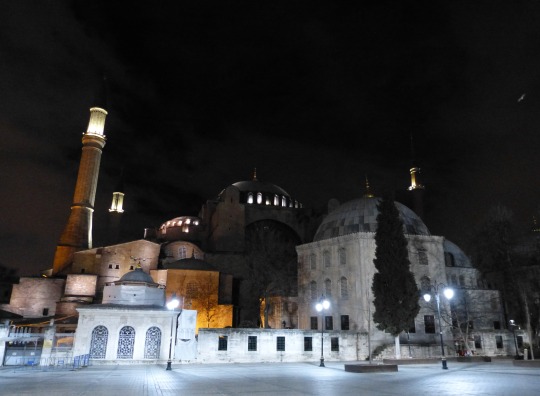
Photos Nathalie (1,2,4-11,14,16-18,22,23) et Bertrand (3,12,13,15,19-21) Donadille, février 2019
Basilique, puis mosquée dans l’ancienne Constantinople*, Sainte-Sophie (Ayasofya en turc) est depuis 1934, dans la nouvelle Istanbul**, un musée “offert à l’humanité” par le fondateur de la République de Turquie, Mustafa Kemal Atatürk.
Son nom grec, Hagia Sophia, signifie “divine sagesse”.
*Lors de la fondation de la cité en 330 par l’empereur Constantin Ier le Grand, ce dernier l’appelle la “Nouvelle Rome”. Ce n’est qu’après sa mort qu’elle deviendra Constantinople, de son nom en grec ancien, Kônstantinoúpolis).
** Lorsque les Ottomans de Mehmet II le Conquérant prennent la ville en 1453, ils la rebaptisent Istanbul (probablement, du grec, “eis tên polin” qui signifie "dans la ville"), mais le terme de Constantinople sera encore utilisé durant cinq siècles, jusqu’en 1930 et l’officialisation de son appellation actuelle .
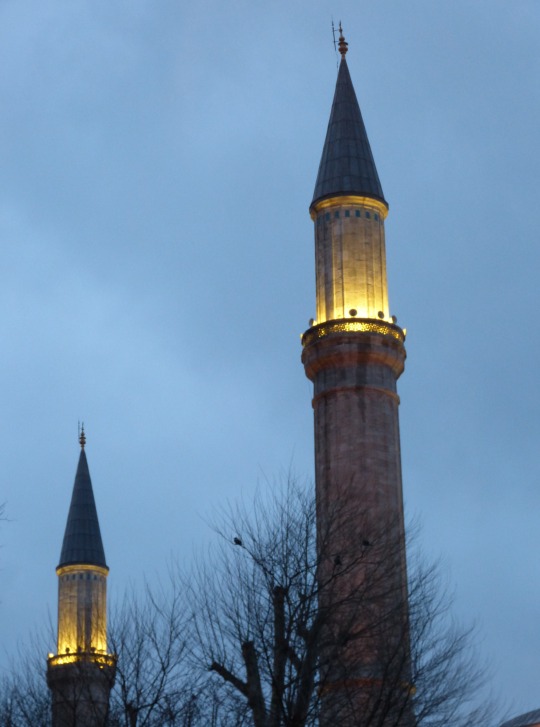
C’est la troisième église de l’histoire édifiée à cet endroit, à l’emplacement d’un temple païen de l’ancienne cité grecque de Byzance. Les deux premières sont détruites par des incendies aux IVe et Ve siècles.
La construction de la basilique que l’on peut admirer est commandée par l’empereur byzantin Justinien en 532. Elle est terminée en 537.
Au fil du temps, les pillages, les incendies et les séismes entrainent de nombreuses destructions et les restaurations qui suivent perdurent encore aujourd’hui.
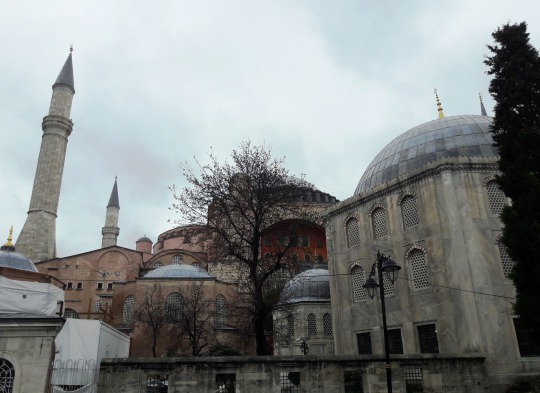
Transformée en mosquée sous la période ottomane par Mehmet II, les musulmans ajoutent des éléments caractéristiques de leurs édifices religieux, tels les quatre minarets élevés au XVe siècle et la fontaine destinée aux ablutions, près de l’entrée sud-ouest, qui date de 1740-1741.

A l’intérieur, les architectures byzantines et ottomanes se côtoient évidemment.
Après l’entrée, le narthex possède un magnifique plafond doré richement décoré.

Dans le vestibule, sur le tympan de la porte donnant accès au narthex, on peut voir, sur cette mosaïque du Xe siècle, la Madonne trônant avec l’Enfant, entourés par les empereurs byzantins, Constantin* (à droite) offrant au Christ la maquette de la ville de Constantinople et Justinien (à gauche) qui lui présente celle de Sainte-Sophie.
* Ce n’est pas Constantin Ier le Grand qui fait construire la première basilique, appelée à l’époque la Grande Eglise, mais son deuxième fils, Constance II le Jeune. Commencée vers 350 et terminée en 360, elle est détruite par le feu en l’an 404.
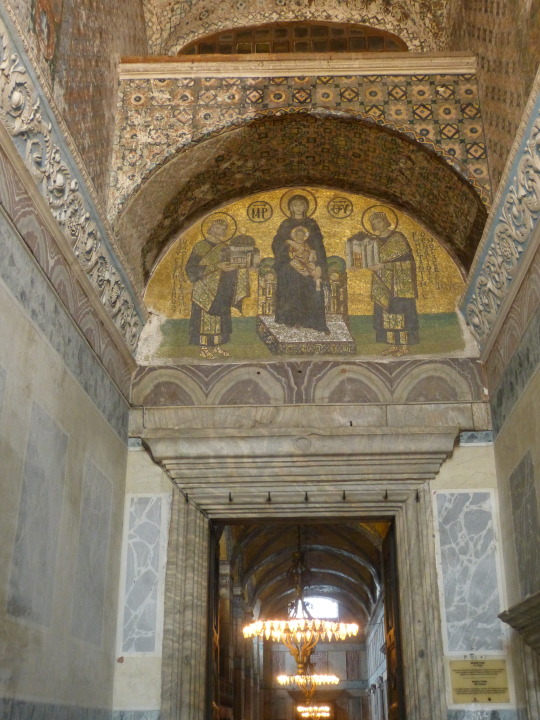
Sur un mur du Narthex sont exposées les reproductions* de cinq grandes plaques sculptées d’un texte en langue grecque qui énumère les canons édictés par les évêques orthodoxes à l’issue du grand concile de Constantinople de 1166 réuni pour envisager les déviations théologiques en matière de dogme trinitaire.
Cette question du Filioque divise l’Eglise romaine et l’Eglise grecque depuis le VIIIe siècle. C’est l’une des deux raisons principales, avec celle du rôle de l’évêque de Rome, qui sont à l’origine du schisme de 1054 entre les Eglises d’Orient et d’Occident et de la naissance des Eglises catholique et orthodoxe.
* Les pierres gravées originelles sont déposées à l’époque dans l’église Sainte-Sophie.

Dans la nef centrale, les éléments ajoutés par les Ottomans se mêlent à la structure architecturale byzantine.
Sur quatre panneaux ronds en chanvre (les cintres sont en bois de tilleul) du XIXe siècle sont calligraphiés en lettres d’or arabes, les noms d’Allah, de Mahomet et des quatre premiers califes.
Ils sont visibles depuis les différentes parties de la basilique.

Vue depuis la loge des impératrices byzantines située sur la galerie supérieure ouest, au-dessus du narthex.
En face, se trouvent le choeur, chrétien, ainsi que le minbar et le mihrab, islamiques.
(On ne peut pas voir la loge du sultan qui se trouve à gauche sous des échafaudages au moment de notre visite)

Vue, depuis la tribune nord, sur la tribune sud

Vue depuis l'abside
Au plafond, on aperçoit une demi-coupole* (une seconde joue le même rôle de l’autre côté) qui épaule la coupole centrale (ci-dessous).
* Chaque demi-coupole est flanquée à son tour de chaque côté par des voûtements en cascade. Tout cet ensemble donne cette impression de légèreté à la nef malgré ses dimensions extraordinaires : 77 m x 71 m (surtout pour l’époque).

Cette dernière a une hauteur de 55,60 m par rapport au sol. Son diamètre est de 31,87 m dans la direction nord-sud et de 30,86 m dans la direction est-ouest. Elle est entourée de 40 fenêtres cintrées. Elle représente le ciel, royaume de Dieu.
La coupole subit plusieurs fois des dommages au cours des siècles. Deux sont plus importants que les autres : en 558, un effondrement partiel du dôme provoqué par un tremblement de terre entraine la restauration de la coupole, puis, en 989, à la suite d’un nouveau séisme, dôme et coupole sont entièrement reconstruits.
Dans l’absidiole (petite chapelle en hémicycle. Ici, dans le prolongement de l’abside), des représentations symboliques des deux religions coexistent.
On trouve sur la conque absidale (partie circulaire terminant la grande nef d'une église) une mosaïque chrétienne de la Vierge et l’enfant, dite de la Theotokos (“mère de dieu” ou, “qui a enfanté dieu”), inaugurée le jour de Pâques 867.
Il y a également le mirhab, islamique, du XIXe siècle, indiquant la direction de La Mecque. Il est décentré par rapport à l’axe de la basilique orienté vers Jérusalem (au sud-est) et a remplacé le grand autel qui était dans le choeur.
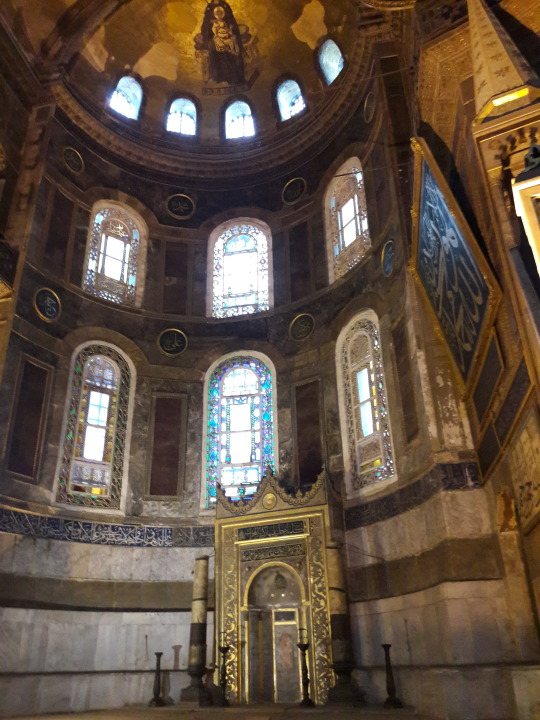
Dans l’abside s’élève le minbar du haut duquel le khatib (prédicateur) prêche lors de la prière du vendredi.
Il remonte à la période du sultan Murad III (1574-1595).

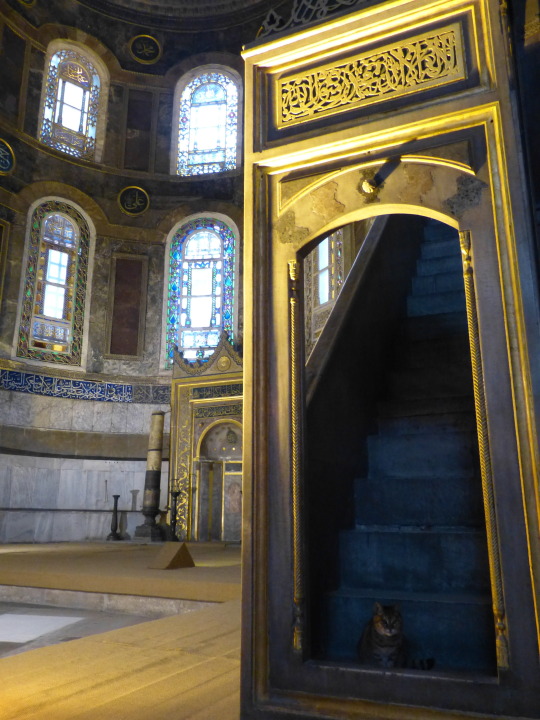
Au sud-est de la nef centrale, au niveau du minbar, se situe l’omphalos*(omphalion en anglais), l'emplacement où a lieu la cérémonie de couronnement des empereurs byzantins.
* Ce mot grec signifie “nombril”. Dans la Grèce antique, c’est une pierre sacrée présentée dans la fosse oraculaire du temple de Delphes, où parle l'oracle d'Apollon, qui symbolise le nombril terrestre, l’origine du monde.

Ce pavement en opus sectile* est composé de grandes pièces de marbre de différentes couleurs dont 32 rotae (Latin : roue, pièce circulaire) en porphyre rouge et vert, en granit vert et rose, ou encore, en pierre verte de Thessalie.
* Technique de mosaÏque constituée par la juxtaposition de fragment de pierre colorées, taillées sur mesure, qui s’emboîtent les unes avec les autres, comme une marqueterie, pour former des motifs géométriques ou figuratifs.
On peut admirer également dans la travée latérale (le bas-côté) sud de la nef, la porte et les grilles, en bronze, de la bibliothèque de Mahmud Ier construite en 1739 lors de la restauration de l’édifice.


La nef centrale est séparée des bas-côtés par des colonnes de marbre vert (ici, dans la zone sud), d’une hauteur de 11 mètres, qui selon la légende proviennent du Temple de Diane d’Ephèse. En réalité, elles sont spécialement taillées pour Sainte-Sophie.
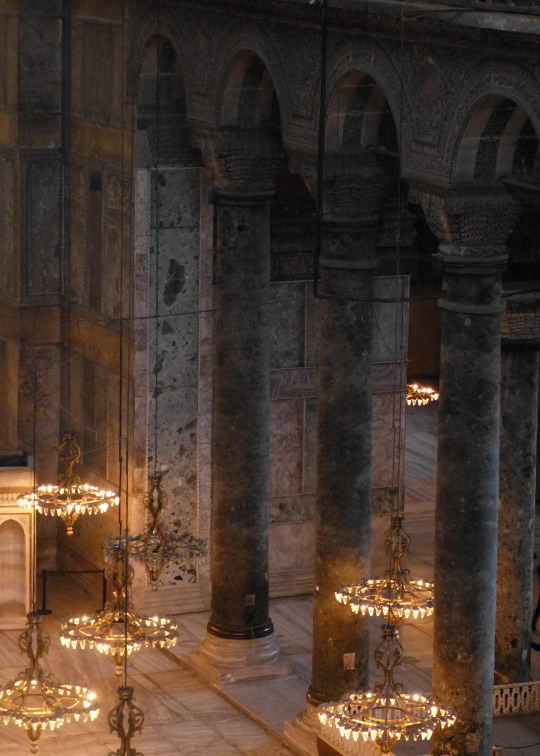
Au-dessus des travées latérales se trouvent les galeries supérieures auxquelles on accède par des rampes placées aux extrémités de la basilique.

Rampe nord-est
A l’étage, la Porte de marbre sépare la galerie ouest et la galerie sud dans laquelle se réunissaient les membres du patriarcat pour les grandes assemblées ecclésiastiques et où s’est tenu le synode de 1166.
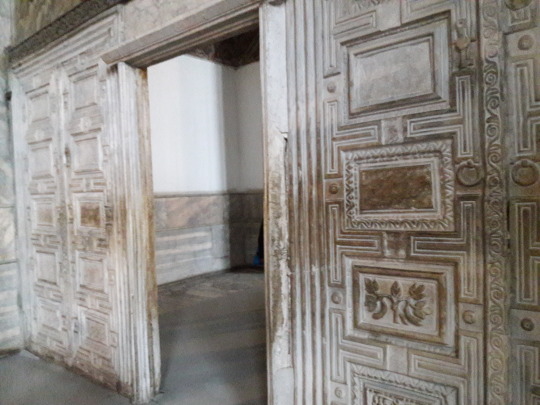
C’est sur le mur ouest de cette dernière galerie que l’on peut voir la Mosaïque de la Deisis*, datant probablement de 1261, où Saint Jean-Baptiste et la Vierge Marie intercèdent auprès du Christ Pantocrator pour le salut de l'humanité lors du Jugement dernier, un thème fréquemment représenté dans l’art chrétien et plus particulièrement dans l’art byzantin.
* En grec, “deisis” veut dire “prière” ou “intercession”.
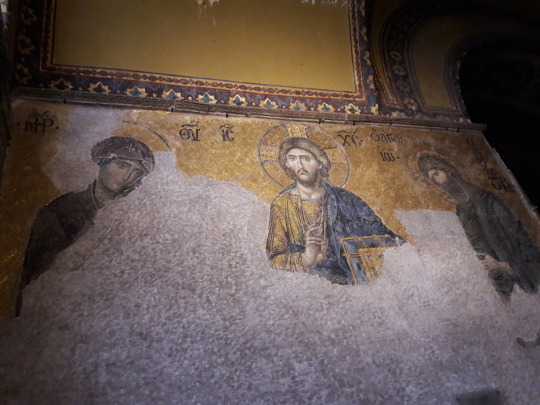
On peut apercevoir par les ouvertures sur l’extérieur de l’étage, la Mosquée Bleue...

... ainsi que l’enceinte où on peut visiter le mausolée du sultan Selim II (XVIe siècle) et les tombeaux de ses descendants (accessible par une entrée différente de celle de Sainte-Sophie et gratuit).

Précédemment : La Mosquée Bleue d’Istanbul
A suivre : Quartier d'Ortaköy, ISTANBUL
#voyage#europe#basilique sainte sophie#sultanahmet#district de fatih#istanbul#thrace orientale#balkans#turquie#monument#église#basilique#mosquée#minaret#fontaine aux abblutions#mirhab#minbar#art#architecture#omphalos#abside#nef#coupole#colonne#porte#galerie#mosaïque#histoire#byzance#constantinople
1 note
·
View note
Text
La Mosquée Bleue d’Istanbul

Sultanahmet Camii (Mosquée Sultan Ahmed, ou Ahmet), est plus connu sous le nom de Mosquée Bleue, en raison de la couleur de ses faïences à dominante bleue.
Le quartier de Sultanahmet, coeur historique de la vieille ville d’Istanbul, lui doit son appellation
Photos Nathalie (4-6,8-11,14,17,18) et Bertrand (1-3,7,12,13,15,16) Donadille, février 2019
Son nom dérive de celui du Sultan Ahmet Ier (1590-1617) qui a ordonné sa construction (1609-1616) à l’emplacement du palais des empereurs byzantins.
On la considère comme l’ultime exemple de l'architecture ottomane classique.

Jardin et façade nord-est
La coupole centrale mesure 23 mètres de diamètre et culmine à 43 mètres.
La cour et la salle de prière sont de dimension égale (64 x 72 m).

Salle de prière sous la coupole et cour (à droite)

Portes nord-est de la salle de prière (au centre) et de la cour (à droite)

Entrée nord-est de la cour

Arcade voûtée (revak) entourant la cour
Sultanahmet Camii possède 6 minarets.
A l’époque, la mosquée de La Mecque (Masjid al Haram), le lieu le plus vénéré de l’Islam, en avait le même nombre. Pour faire taire les critiques et régler le problème, Ahmet Ier aurait financé (ce n’est peut-être qu’une légende) l'ajout d’un septième minaret à la “Mosquée sacrée” d’Arabie.

Coupoles au-dessus du revak et minaret
L’intérieur de la salle de prière est orné par plus de 20 000 carreaux de faïence à dominante bleue que le sultan a fait venir de Nicaea (Nicée en français), la ville turque d’Iznik, aujourd’hui.
C’est au niveau de la galerie du premier étage que commence cette décoration.


Le sol est recouvert d’épais tapis...

... et la salle de prière est éclairée par plus de 200 fenêtres aux vitraux colorés.


Le mihrab, la niche qui indique la direction de La Mecque et vers laquelle se tournent les fidèles pour prier, est en marbre blanc de Marmara.

De nuit, la mosquée illuminée est encore plus belle.
Depuis le parc Sultan Ahmet...


... ou l’entrée à l’angle Est.

Et vus depuis l’Hippodrome, les minarets, tels des fusées sur leur pas de tir !


A suivre : La byzantine Sainte-Sophie
#voyage#europe#sultanahmet#district de fatih#istanbul#thrace orientale#balkans#turquie#ville#quartier#monument#mosquée bleue#architecture ottomane#minaret#porte#cour#coupole#arcade#galerie#faïence d'iznik#hippodrome d'istanbul#histoire#empire ottoman#sultan ahmet 1er#nicée#mosquée de la mecque#marbre de marmara#nature#parc sultan ahmet#jardin
0 notes
Text
Events 7.3
324 – Battle of Adrianople: Constantine I defeats Licinius, who flees to Byzantium. 987 – Hugh Capet is crowned King of France, the first of the Capetian dynasty that would rule France until the French Revolution in 1792. 1035 – William the Conqueror becomes the Duke of Normandy, reigns until 1087. 1608 – Québec City is founded by Samuel de Champlain. 1754 – French and Indian War: George Washington surrenders Fort Necessity to French forces. 1767 – Pitcairn Island is discovered by Midshipman Robert Pitcairn on an expeditionary voyage commanded by Philip Carteret. 1767 – Norway's oldest newspaper still in print, Adresseavisen, is founded and the first edition is published. 1775 – American Revolutionary War: George Washington takes command of the Continental Army at Cambridge, Massachusetts. 1778 – American Revolutionary War: Iroquois allied to Britain kill 360 people in the Wyoming Valley massacre. 1819 – The Bank for Savings in the City of New-York, the first savings bank in the United States, opens. 1839 – The first state normal school in the United States, the forerunner to today's Framingham State University, opens in Lexington, Massachusetts with three students. 1848 – Governor-General Peter von Scholten emancipates all remaining slaves in the Danish West Indies. 1849 – France invades the Roman Republic and restores the Papal States. 1852 – Congress establishes the United States' 2nd mint in San Francisco. 1863 – American Civil War: The final day of the Battle of Gettysburg culminates with Pickett's Charge. 1866 – Austro-Prussian War is decided at the Battle of Königgrätz, resulting in Prussia taking over as the prominent German nation from Austria. 1884 – Dow Jones & Company publishes its first stock average. 1886 – Karl Benz officially unveils the Benz Patent-Motorwagen, the first purpose-built automobile. 1886 – The New-York Tribune becomes the first newspaper to use a linotype machine, eliminating typesetting by hand. 1890 – Idaho is admitted as the 43rd U.S. state. 1898 – A Spanish squadron, led by Pascual Cervera y Topete, is defeated by an American squadron under William T. Sampson in the Battle of Santiago de Cuba. 1913 – Confederate veterans at the Great Reunion of 1913 reenact Pickett's Charge; upon reaching the high-water mark of the Confederacy they are met by the outstretched hands of friendship from Union survivors. 1938 – World speed record for a steam locomotive is set in England, by the Mallard, which reaches a speed of 125.88 miles per hour (202.58 km/h). 1938 – United States President Franklin D. Roosevelt dedicates the Eternal Light Peace Memorial and lights the eternal flame at Gettysburg Battlefield. 1940 – World War II: The Royal Navy attacks the French naval squadron in Algeria, to ensure that it will not fall under German control. Of the four French battleships present, one is sunk, two are damaged, and one escapes back to France. 1944 – World War II: The Minsk Offensive clears German troops from the city. 1952 – The Constitution of Puerto Rico is approved by the United States Congress. 1952 – The SS United States sets sail on her maiden voyage to Southampton. During the voyage, the ship takes the Blue Riband away from the RMS Queen Mary. 1967 – The Aden Emergency: The Battle of the Crater in which the British Argyll and Sutherland Highlanders retake the Crater district following the Arab Police mutiny. 1969 – Space Race: The biggest explosion in the history of rocketry occurs when the Soviet N-1 rocket explodes and subsequently destroys its launchpad. 1970 – The Troubles: The "Falls Curfew" begins in Belfast, Northern Ireland. 1970 – Dan-Air Flight 1903 crashes into the Les Agudes mountain in the Montseny Massif near the village of Arbúcies in Catalonia, Spain, killing all 112 people aboard. 1979 – U.S. President Jimmy Carter signs the first directive for secret aid to the opponents of the pro-Soviet regime in Kabul. 1988 – United States Navy warship USS Vincennes shoots down Iran Air Flight 655 over the Persian Gulf, killing all 290 people aboard. 1988 – The Fatih Sultan Mehmet Bridge in Istanbul, Turkey is completed, providing the second connection between the continents of Europe and Asia over the Bosphorus. 1996 – British Prime Minister John Major announced the Stone of Scone would be returned to Scotland. 2013 – Egyptian coup d'état: President of Egypt Mohamed Morsi is overthrown by the military after four days of protests all over the country calling for Morsi's resignation, to which he did not respond. President of the Supreme Constitutional Court of Egypt Adly Mansour is declared acting president. 2021 – The United Nations announces that recent fighting in the Tigray region of Ethiopia has resulted in a famine that is now affecting more than 400,000 people. 2021 – Over 130 wildfires, largely ignited by lightning strikes, burn in Western Canada following a record-breaking heatwave. 2021 – Twenty people go missing after a large landslide hits Atami city in central Japan.
0 notes
Text
Events 7.3
324 – Battle of Adrianople: Constantine I defeats Licinius, who flees to Byzantium. 987 – Hugh Capet is crowned King of France, the first of the Capetian dynasty that would rule France until the French Revolution in 1792. 1035 – William the Conqueror becomes the Duke of Normandy, reigns until 1087. 1608 – Québec City is founded by Samuel de Champlain. 1754 – French and Indian War: George Washington surrenders Fort Necessity to French forces. 1767 – Pitcairn Island is discovered by Midshipman Robert Pitcairn on an expeditionary voyage commanded by Philip Carteret. 1767 – Norway's oldest newspaper still in print, Adresseavisen, is founded and the first edition is published. 1775 – American Revolutionary War: George Washington takes command of the Continental Army at Cambridge, Massachusetts. 1778 – American Revolutionary War: Iroquois allied to Britain kill 360 people in the Wyoming Valley massacre. 1819 – The Bank for Savings in the City of New-York, the first savings bank in the United States, opens. 1839 – The first state normal school in the United States, the forerunner to today's Framingham State University, opens in Lexington, Massachusetts with three students. 1844 – The last pair of great auks is killed. 1848 – Governor-General Peter von Scholten emancipates all remaining slaves in the Danish West Indies. 1849 – France invades the Roman Republic and restores the Papal States. 1852 – Congress establishes the United States' 2nd mint in San Francisco. 1863 – American Civil War: The final day of the Battle of Gettysburg culminates with Pickett's Charge. 1866 – Austro-Prussian War is decided at the Battle of Königgrätz, resulting in Prussia taking over as the prominent German nation from Austria. 1884 – Dow Jones & Company publishes its first stock average. 1886 – Karl Benz officially unveils the Benz Patent-Motorwagen, the first purpose-built automobile. 1886 – The New-York Tribune becomes the first newspaper to use a linotype machine, eliminating typesetting by hand. 1890 – Idaho is admitted as the 43rd U.S. state. 1898 – A Spanish squadron, led by Pascual Cervera y Topete, is defeated by an American squadron under William T. Sampson in the Battle of Santiago de Cuba. 1913 – Confederate veterans at the Great Reunion of 1913 reenact Pickett's Charge; upon reaching the high-water mark of the Confederacy they are met by the outstretched hands of friendship from Union survivors. 1938 – World speed record for a steam locomotive is set in England, by the Mallard, which reaches a speed of 125.88 miles per hour (202.58 km/h). 1938 – United States President Franklin D. Roosevelt dedicates the Eternal Light Peace Memorial and lights the eternal flame at Gettysburg Battlefield. 1940 – World War II: The Royal Navy attacks the French naval squadron in Algeria, to ensure that it will not fall under German control. Of the four French battleships present, one is sunk, two are damaged, and one escapes back to France. 1944 – World War II: The Minsk Offensive clears German troops from the city. 1952 – The Constitution of Puerto Rico is approved by the United States Congress. 1952 – The SS United States sets sail on her maiden voyage to Southampton. During the voyage, the ship takes the Blue Riband away from the RMS Queen Mary. 1967 – The Aden Emergency: The Battle of the Crater in which the British Argyll and Sutherland Highlanders retake the Crater district following the Arab Police mutiny. 1969 – Space Race: The biggest explosion in the history of rocketry occurs when the Soviet N-1 rocket explodes and subsequently destroys its launchpad. 1970 – The Troubles: The "Falls Curfew" begins in Belfast, Northern Ireland. 1970 – Dan-Air Flight 1903 crashes into the Les Agudes mountain in the Montseny Massif near the village of Arbúcies in Catalonia, Spain, killing all 112 people aboard. 1979 – U.S. President Jimmy Carter signs the first directive for secret aid to the opponents of the pro-Soviet regime in Kabul. 1988 – United States Navy warship USS Vincennes shoots down Iran Air Flight 655 over the Persian Gulf, killing all 290 people aboard. 1988 – The Fatih Sultan Mehmet Bridge in Istanbul, Turkey is completed, providing the second connection between the continents of Europe and Asia over the Bosphorus. 1995 – Saint Kitts and Nevis Labour Party wins the general elections and is restored to power after being in opposition for 15 years. 1996 – British Prime Minister John Major announced the Stone of Scone would be returned to Scotland. 2013 – Egyptian coup d'état: President of Egypt Mohamed Morsi is overthrown by the military after four days of protests all over the country calling for Morsi's resignation, to which he did not respond. President of the Supreme Constitutional Court of Egypt Adly Mansour is declared acting president.
0 notes
Text
Events 7.3
324 – Battle of Adrianople: Constantine I defeats Licinius, who flees to Byzantium. 987 – Hugh Capet is crowned King of France, the first of the Capetian dynasty that would rule France until the French Revolution in 1792. 1035 – William the Conqueror becomes the Duke of Normandy, reigns until 1087. 1608 – Québec City is founded by Samuel de Champlain. 1754 – French and Indian War: George Washington surrenders Fort Necessity to French forces. 1767 – Pitcairn Island is discovered by Midshipman Robert Pitcairn on an expeditionary voyage commanded by Philip Carteret. 1767 – Norway's oldest newspaper still in print, Adresseavisen, is founded and the first edition is published. 1775 – American Revolutionary War: George Washington takes command of the Continental Army at Cambridge, Massachusetts. 1778 – American Revolutionary War: Iroquois allied to Britain kill 360 people in the Wyoming Valley massacre. 1819 – The Bank for Savings in the City of New-York, the first savings bank in the United States, opens. 1839 – The first state normal school in the United States, the forerunner to today's Framingham State University, opens in Lexington, Massachusetts with three students. 1844 – The last pair of great auks is killed. 1848 – Governor-General Peter von Scholten emancipates all remaining slaves in the Danish West Indies. 1849 – France invades the Roman Republic and restores the Papal States. 1852 – Congress establishes the United States' 2nd mint in San Francisco. 1863 – American Civil War: The final day of the Battle of Gettysburg culminates with Pickett's Charge. 1866 – Austro-Prussian War is decided at the Battle of Königgrätz, resulting in Prussia taking over as the prominent German nation from Austria. 1884 – Dow Jones & Company publishes its first stock average. 1886 – Karl Benz officially unveils the Benz Patent-Motorwagen, the first purpose-built automobile. 1886 – The New-York Tribune becomes the first newspaper to use a linotype machine, eliminating typesetting by hand. 1890 – Idaho is admitted as the 43rd U.S. state. 1898 – A Spanish squadron, led by Pascual Cervera y Topete, is defeated by an American squadron under William T. Sampson in the Battle of Santiago de Cuba. 1913 – Confederate veterans at the Great Reunion of 1913 reenact Pickett's Charge; upon reaching the high-water mark of the Confederacy they are met by the outstretched hands of friendship from Union survivors. 1938 – World speed record for a steam locomotive is set in England, by the Mallard, which reaches a speed of 125.88 miles per hour (202.58 km/h). 1938 – United States President Franklin D. Roosevelt dedicates the Eternal Light Peace Memorial and lights the eternal flame at Gettysburg Battlefield. 1940 – World War II: To stop ships from falling into German hands the French fleet of the Atlantic based at Mers El Kébir, is bombarded by the British fleet, coming from Gibraltar, causing the loss of three battleships: Dunkerque, Provence and French battleship Bretagne. One thousand two hundred sailors perish. 1944 – World War II: Minsk is liberated from Nazi control by Soviet troops during Operation Bagration. 1952 – The Constitution of Puerto Rico is approved by the United States Congress. 1952 – The SS United States sets sail on her maiden voyage to Southampton. During the voyage, the ship takes the Blue Riband away from the RMS Queen Mary. 1962 – Jackie Robinson becomes the first African American to be inducted into the National Baseball Hall of Fame. 1967 – The Aden Emergency: The Battle of the Crater in which the British Argyll and Sutherland Highlanders retake the Crater district following the Arab Police mutiny. 1969 – Space Race: The biggest explosion in the history of rocketry occurs when the Soviet N-1 rocket explodes and subsequently destroys its launchpad. 1970 – The Troubles: The "Falls Curfew" begins in Belfast, Northern Ireland. 1979 – U.S. President Jimmy Carter signs the first directive for secret aid to the opponents of the pro-Soviet regime in Kabul. 1988 – United States Navy warship USS Vincennes shoots down Iran Air Flight 655 over the Persian Gulf, killing all 290 people aboard. 1988 – The Fatih Sultan Mehmet Bridge in Istanbul, Turkey is completed, providing the second connection between the continents of Europe and Asia over the Bosphorus. 1995 – Saint Kitts and Nevis Labour Party wins the general elections and is restored to power after being in opposition for 15 years. 1996 – Stone of Scone is returned to Scotland. 2013 – Egyptian coup d'état: President of Egypt Mohamed Morsi is overthrown by the military after four days of protests all over the country calling for Morsi's resignation, to which he did not respond. President of the Supreme Constitutional Court of Egypt Adly Mansour is declared acting president.
0 notes
Text
Events 7.3
324 – Battle of Adrianople: Constantine I defeats Licinius, who flees to Byzantium. 987 – Hugh Capet is crowned King of France, the first of the Capetian dynasty that would rule France until the French Revolution in 1792. 1035 – William the Conqueror becomes the Duke of Normandy, reigns until 1087. 1608 – Québec City is founded by Samuel de Champlain. 1754 – French and Indian War: George Washington surrenders Fort Necessity to French forces. 1767 – Pitcairn Island is discovered by Midshipman Robert Pitcairn on an expeditionary voyage commanded by Philip Carteret. 1767 – Norway's oldest newspaper still in print, Adresseavisen, is founded and the first edition is published. 1775 – American Revolutionary War: George Washington takes command of the Continental Army at Cambridge, Massachusetts. 1778 – American Revolutionary War: Iroquois allied to Britain kill 360 people in the Wyoming Valley massacre. 1819 – The Bank for Savings in the City of New-York, the first savings bank in the United States, opens. 1839 – The first state normal school in the United States, the forerunner to today's Framingham State University, opens in Lexington, Massachusetts with three students. 1844 – The last pair of great auks is killed. 1848 – Governor-General Peter von Scholten emancipates all remaining slaves in the Danish West Indies. 1849 – France invades the Roman Republic and restores the Papal States. 1852 – Congress establishes the United States' 2nd mint in San Francisco. 1863 – American Civil War: The final day of the Battle of Gettysburg culminates with Pickett's Charge. 1866 – Austro-Prussian War is decided at the Battle of Königgrätz, resulting in Prussia taking over as the prominent German nation from Austria. 1884 – Dow Jones & Company publishes its first stock average. 1886 – Karl Benz officially unveils the Benz Patent-Motorwagen, the first purpose-built automobile. 1886 – The New-York Tribune becomes the first newspaper to use a linotype machine, eliminating typesetting by hand. 1890 – Idaho is admitted as the 43rd U.S. state. 1898 – A Spanish squadron, led by Pascual Cervera y Topete, is defeated by an American squadron under William T. Sampson in the Battle of Santiago de Cuba. 1913 – Confederate veterans at the Great Reunion of 1913 reenact Pickett's Charge; upon reaching the high-water mark of the Confederacy they are met by the outstretched hands of friendship from Union survivors. 1938 – World speed record for a steam locomotive is set in England, by the Mallard, which reaches a speed of 125.88 miles per hour (202.58 km/h). 1938 – United States President Franklin D. Roosevelt dedicates the Eternal Light Peace Memorial and lights the eternal flame at Gettysburg Battlefield. 1940 – World War II: To stop ships from falling into German hands the French fleet of the Atlantic based at Mers El Kébir, is bombarded by the British fleet, coming from Gibraltar, causing the loss of three battleships: Dunkerque, Provence and French battleship Bretagne. One thousand two hundred sailors perish. 1944 – World War II: Minsk is liberated from Nazi control by Soviet troops during Operation Bagration. 1952 – The Constitution of Puerto Rico is approved by the United States Congress. 1952 – The SS United States sets sail on her maiden voyage to Southampton. During the voyage, the ship takes the Blue Riband away from the RMS Queen Mary. 1962 – Jackie Robinson becomes the first African American to be inducted into the National Baseball Hall of Fame. 1967 – The Aden Emergency: The Battle of the Crater in which the British Argyll and Sutherland Highlanders retake the Crater district following the Arab Police mutiny. 1969 – Space Race: The biggest explosion in the history of rocketry occurs when the Soviet N-1 rocket explodes and subsequently destroys its launchpad. 1970 – The Troubles: The "Falls Curfew" begins in Belfast, Northern Ireland. 1979 – U.S. President Jimmy Carter signs the first directive for secret aid to the opponents of the pro-Soviet regime in Kabul. 1988 – United States Navy warship USS Vincennes shoots down Iran Air Flight 655 over the Persian Gulf, killing all 290 people aboard. 1988 – The Fatih Sultan Mehmet Bridge in Istanbul, Turkey is completed, providing the second connection between the continents of Europe and Asia over the Bosphorus. 1995 – Saint Kitts and Nevis Labour Party wins the general elections and is restored to power after being in opposition for 15 years. 1996 – Stone of Scone is returned to Scotland. 2013 – Egyptian coup d'état: President of Egypt Mohamed Morsi is overthrown by the military after four days of protests all over the country calling for Morsi's resignation, to which he didn't respond. President of the Supreme Constitutional Court of Egypt Adly Mansour is declared acting president.
0 notes
Text
Events 7.3
324 – Battle of Adrianople: Constantine I defeats Licinius, who flees to Byzantium. 987 – Hugh Capet is crowned King of France, the first of the Capetian dynasty that would rule France until the French Revolution in 1792. 1035 – William the Conqueror becomes the Duke of Normandy, reigns until 1087. 1608 – Québec City is founded by Samuel de Champlain. 1754 – French and Indian War: George Washington surrenders Fort Necessity to French forces. 1767 – Pitcairn Island is discovered by Midshipman Robert Pitcairn on an expeditionary voyage commanded by Philip Carteret. 1767 – Norway's oldest newspaper still in print, Adresseavisen, is founded and the first edition is published. 1775 – American Revolutionary War: George Washington takes command of the Continental Army at Cambridge, Massachusetts. 1778 – American Revolutionary War: Iroquois allied to Britain kill 360 people in the Wyoming Valley massacre. 1819 – The Bank of Savings in New York City, the first savings bank in the United States, opens. 1839 – The first state normal school in the United States, the forerunner to today's Framingham State University, opens in Lexington, Massachusetts with three students. 1844 – The last pair of great auks is killed. 1848 – Slaves are freed in the Danish West Indies (now U.S. Virgin Islands). 1849 – The French enter Rome in order to restore Pope Pius IX to power. This would prove a major obstacle to Italian unification. 1852 – Congress establishes the United States' 2nd mint in San Francisco. 1863 – American Civil War: The final day of the Battle of Gettysburg culminates with Pickett's Charge. 1866 – Austro-Prussian War is decided at the Battle of Königgrätz, resulting in Prussia taking over as the prominent German nation from Austria. 1884 – Dow Jones & Company publishes its first stock average. 1886 – Karl Benz officially unveils the Benz Patent-Motorwagen, the first purpose-built automobile. 1886 – The New-York Tribune becomes the first newspaper to use a linotype machine, eliminating typesetting by hand. 1890 – Idaho is admitted as the 43rd U.S. state. 1898 – A Spanish squadron, led by Pascual Cervera y Topete, is defeated by an American squadron under William T. Sampson in the Battle of Santiago de Cuba. 1913 – Confederate veterans at the Great Reunion of 1913 reenact Pickett's Charge; upon reaching the high-water mark of the Confederacy they are met by the outstretched hands of friendship from Union survivors. 1938 – World speed record for a steam locomotive is set in England, by the Mallard, which reaches a speed of 125.88 miles per hour (202.58 km/h). 1938 – United States President Franklin D. Roosevelt dedicates the Eternal Light Peace Memorial and lights the eternal flame at Gettysburg Battlefield. 1940 – World War II: To stop ships from falling into German hands the French fleet of the Atlantic based at Mers El Kébir, is bombarded by the British fleet, coming from Gibraltar, causing the loss of three battleships: Dunkerque, Provence and French battleship Bretagne. One thousand two hundred sailors perish. 1944 – World War II: Minsk is liberated from Nazi control by Soviet troops during Operation Bagration. 1952 – The Constitution of Puerto Rico is approved by the United States Congress. 1952 – The SS United States sets sail on her maiden voyage to Southampton. During the voyage, the ship takes the Blue Riband away from the RMS Queen Mary. 1967 – The Aden Emergency: The Battle of the Crater in which the British Argyll and Sutherland Highlanders retake the Crater district following the Arab Police mutiny. 1969 – Space Race: The biggest explosion in the history of rocketry occurs when the Soviet N-1 rocket explodes and subsequently destroys its launchpad. 1970 – The Troubles: The "Falls Curfew" begins in Belfast, Northern Ireland. 1979 – U.S. President Jimmy Carter signs the first directive for secret aid to the opponents of the pro-Soviet regime in Kabul. 1988 – United States Navy warship USS Vincennes shoots down Iran Air Flight 655 over the Persian Gulf, killing all 290 people aboard. 1988 – The Fatih Sultan Mehmet Bridge in Istanbul, Turkey is completed, providing the second connection between the continents of Europe and Asia over the Bosphorus. 1995 – Saint Kitts and Nevis Labour Party wins the general elections and is restored to power after being in opposition for 15 years. 1996 – Stone of Scone is returned to Scotland. 2013 – Egyptian coup d'état: President of Egypt Mohamed Morsi is overthrown by the military after four days of protests all over the country calling for Morsi's resignation, to which he didn't respond. President of the Supreme Constitutional Court of Egypt Adly Mansour is declared acting president.
0 notes